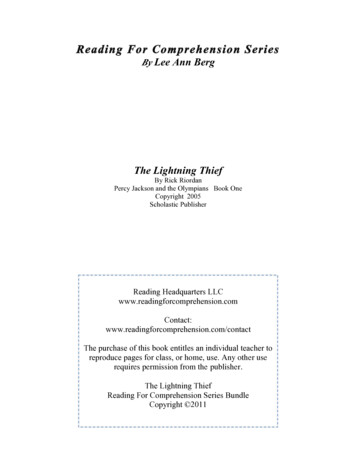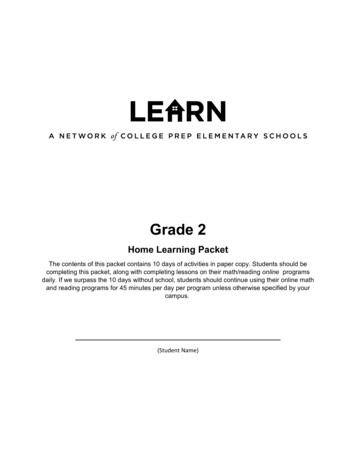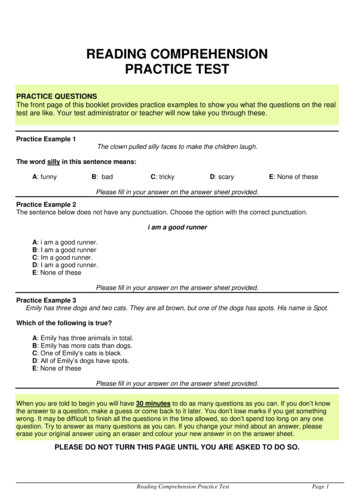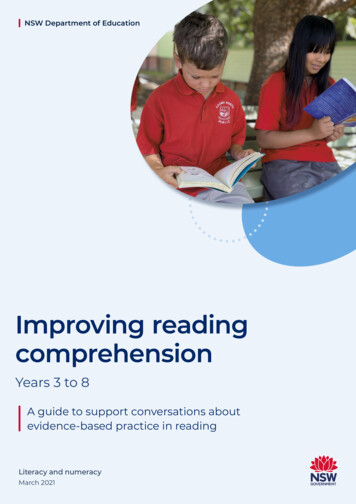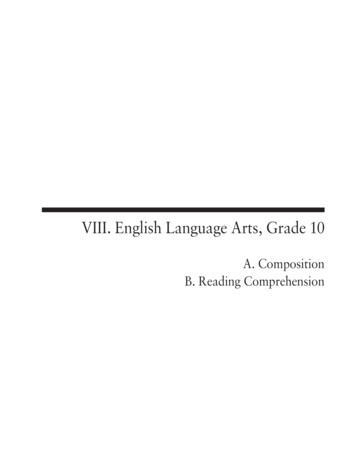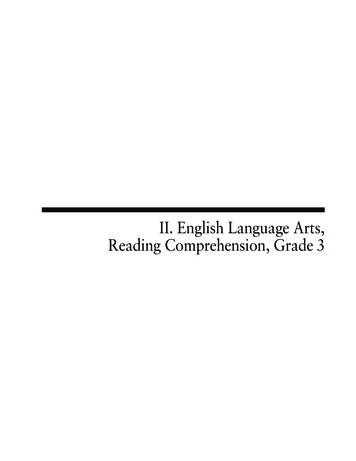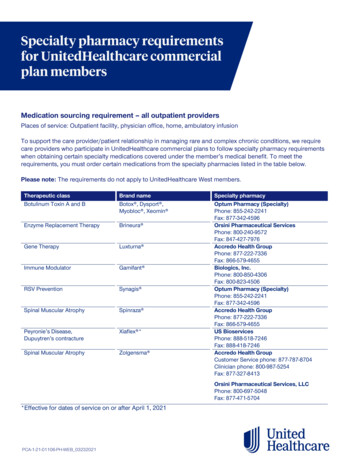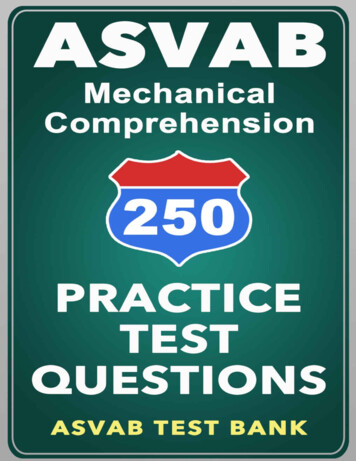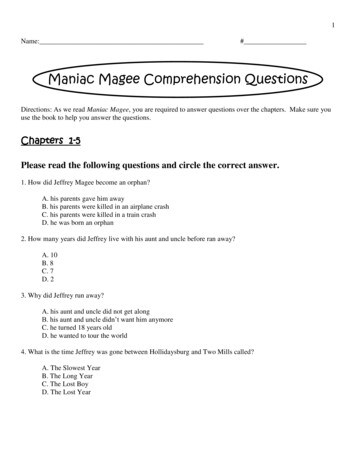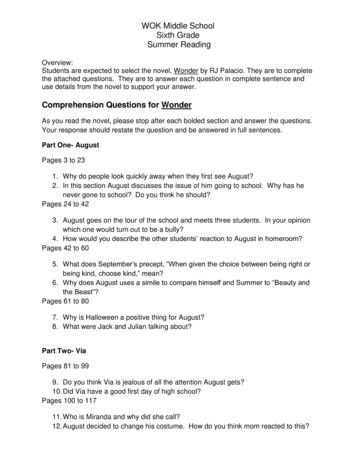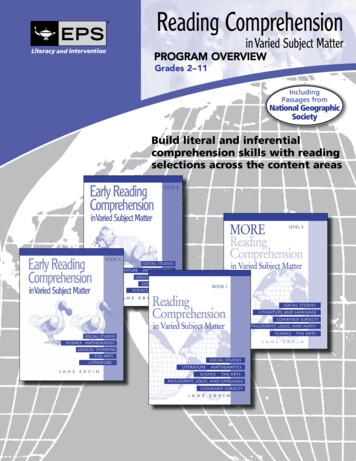
Transcription
Reading Comprehensionin Varied Subject MatterProgram OverviewGrades 2–11IncludingPassages fromNational GeographicSocietyBuild literal and inferentialcomprehension skills with readingselections across the content areasFor detailed product information, visit epsbooks.com/RCVSM.1
What is Reading Comprehension in Varied Subject Matter?Reading Comprehension spans grades 2–11and comprises fourteen student books. Theseries offers nonfiction reading passageswith comprehension questions on a varietyof subjects. Topics and questions prepare students forstandardized tests and provide valuablepractice in nonfiction reading comprehension.Short passages on a variety of topics arefollowed by varied comprehension exercisesincluding story recall, inferential questions,and writing prompts.Reading passages promote thinking andlearning across the content areas and includetopics in science, social studies, literature,math, and more.The Early Reading Comprehension workbooks(Books A–D) are for young readers, specificallygrades 2 through 4. Reading Comprehension(Books 1–6) targets grades 3 through 8, andMORE Reading Comprehension (Levels 1–4) isdesigned for junior high and older students.The entire Reading Comprehension series isparticularly useful in a classroom that has studentsof varying reading abilities. The consistent formatallows students in the same class to use differentlevels in the series. Students gain confidence andincrease their reading, language, and comprehension skills as they progress through the series.Visit epsbooks.com/RCVSMto find Sample lessons2 to order:Call 800.225.5750 Fax 888.440.2665 Online epsbooks.com
Features for You Passages include a variety of contentarea topics, allowing for cross-curricularreading practice.Each passage for grades 2–11 is followed bya writing response prompt, similar to thoseencountered on many standardized tests.Vocabulary development exercises areincorporated into each lesson as studentsidentify and define key words from thepassages.The Reason for Reading prompt precedingeach passage sets a purpose for reading.Benefits for Your Students Students maintain interest and increasetheir knowledge as they read nonfictionpassages across the content areas.Students learn to think critically andrespond to texts in writing as they buildlanguage and comprehension skills.Students increase their comprehensionand understanding and they buildessential vocabulary skills in context.Students activate prior knowledge andbring what they know to the topic.Skills AddressedEarly Reading Comprehension(Grades 2–4)MORE Reading Comprehension(Grades 8–11) Story elements Story recall Literal comprehension questions Sequencing Recalling the main idea and details Drawing conclusions Sequencing Vocabulary development Matching vocabulary words with meanings Main idea Responding to reading passages Extending thoughts in writing InferenceReading Comprehension(Grades 3–8) Story recall Sequencing Drawing conclusions Vocabulary development Main idea Extending thoughts in writing InferenceFor detailed product information, visit epsbooks.com/RCVSM.3
Types of ExercisesReading Comprehension andMORE Reading ComprehensionEarly ReadingComprehension About the Passage – introduces theselection to the readers and asks themto determine the main ideaCan You Remember? – asks students torecall literal information from the passagePut the Sentences in the Correct Order –lists four sentences from the selection andasks students to sequence them in thecorrect order Match the Words with Their Meanings –asks students to match vocabulary fromthe passage with its meaningWrite about It – providesseveral prompts forstudents to respondcritically to the passagein writing About the Passage – introduces theselection to the reader and activatesprior knowledgeReason for Reading – explains the readingskill being emphasized in the passageThinking It Over – asks two to three broadquestions that students must answer witha complete sentenceStudying the Passage – asks both literaland inferential questions in multiple-choiceand true/false formats including main idea,interpretation, sequencing, and drawingconclusionsUsing the Words – encourages studentsto use vocabulary from the passage in aparagraphWrite about It - provides several promptsfor students to respond critically to thepassage in writing including their owninterpretationsHow can I fit Reading Comprehension into my curriculum?Early Reading Comprehension, Reading Comprehension, and MORE ReadingComprehension can be used in a variety of ways.The program can be used to supplement any existing reading program. Students can beginin second grade with Early Reading Comprehension Book A and move through the series toMORE Reading Comprehension for junior high and high school. The books in this series canalso be used to differentiate instruction. Students can be assigned different selections atdifferent levels according to their skills or interests. In addition, students can read passageson the same theme at different reading levels and discuss them as a group.Early Reading Comprehension, Reading Comprehension, and MORE Reading Comprehensionare perfect for small group and one-on-one instruction with struggling readers or EnglishLanguage Learners.4 to order:Call 800.225.5750 Fax 888.440.2665 Online epsbooks.com
Early Reading Comprehension, Book A, p. 33Passages cover a varietyof content-area topicsincluding science, socialstudies, math, and the arts.For detailed product information, visit epsbooks.com/RCVSM.5
Comprehension exercises followingevery passage promote story recallincluding main idea.Early Reading Comprehension, Book B, p. 33Consistent exercises askstudents to synthesize theinformation they read andsequence events from the story.6 to order:Call 800.225.5750 Fax 888.440.2665 Online epsbooks.com
Passages not only vary in topic but alsoinclude a wide range of formats includingcharts and graphs.Early Reading Comprehension, Book C, p. 14For detailed product information, visit epsbooks.com/RCVSM.7
Exercises promote vocabulary developmentand include vocabulary words taken fromthe reading selection.Early Reading Comprehension, Book D, p. 248 to order:Call 800.225.5750 Fax 888.440.2665 Online epsbooks.com
Reason for Reading explains thereading skill being emphasized inthe passage prior to reading.Reading Comprehension, Book 1, p. 79For detailed product information, visit epsbooks.com/RCVSM.9
Exercises mimic those commonlyfound on standardized assessmentsand provide test-taking practice.Reading Comprehension, Book 3, p. 1810 to order:Call 800.225.5750 Fax 888.440.2665 Online epsbooks.com
Exercises promote both literal and inferentialthinking including drawing inferences andthinking beyond the text.Reading Comprehension, Book 4, p. 48For detailed product information, visit epsbooks.com/RCVSM.11
Students are encouraged to respondto passages in writing and give theirpersonal reactions and interpretations.Reading Comprehension, Book 6, p. 1512 to order:Call 800.225.5750 Fax 888.440.2665 Online epsbooks.com
About the Passage introducesthe selection to the readers,asks them to recall what theyknow, and offers new information.MORE Reading Comprehension, Level 1, p. 40For detailed product information, visit epsbooks.com/RCVSM.13
Passages familiarize students with conventions ofnonfiction and help them to navigate through selectionsinvolving complex and technical language.MORE Reading Comprehension, Level 2, p. 4414 to order:Call 800.225.5750 Fax 888.440.2665 Online epsbooks.com
Pre-reading exercises activate prior knowledgeand provide background information beforestudents read the selection.MORE Reading Comprehension, Level 4, p. 8For detailed product information, visit epsbooks.com/RCVSM.15
WORDLY WISE 3OOO 3rd EditionThe only complete k–12 Vocabulary Program!Grades K–1Oral vocabulary that sets the foundation for reading success!FREEOURCESWEB RESes!GamInteractiveList!Audio Word3000.comWordlyWiseGrades 2–12Advancing into reading and writing vocabulary!Connect with Us!Learn more at epsbooks.com/connecttel 800.225.5750 fax 888.440.2665epsbooks.comScan this codeto visit our website661315-039-POV
Each passage for grades 2–11 is followed by a writing response prompt, similar to those encountered on many standardized tests. Vocabulary development exercises are incorporated into each lesson as students identify and define key words from the passages. The Reason for Reading prompt preceding each passage sets a purpose for reading.
